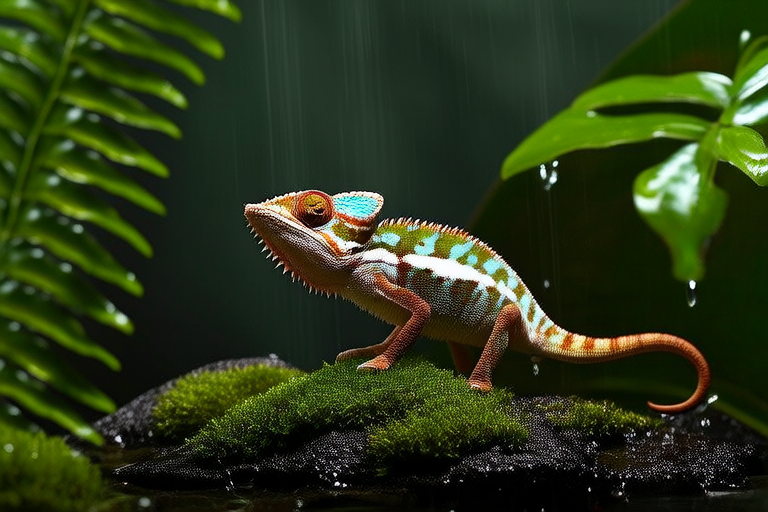The Ultimate Chameleon Habitat Setup: Tips and Tricks
Welcome to your comprehensive guide on creating the perfect habitat for your chameleon. Whether you’re a novice or an experienced reptile owner, this guide will provide you with all the essential information needed to ensure your chameleon thrives in its environment. From enclosure selection to dietary specifics, we’ll cover everything you need to know.
Selecting Appropriate Enclosures
Choosing the right enclosure is crucial for your chameleon’s health and happiness. Enclosures should be tall and spacious, allowing ample room for climbing and exploration. A minimum size of 24x18x36 inches is recommended for adult chameleons, though larger enclosures are always preferable. Opt for mesh-sided tanks to ensure proper ventilation and prevent heat build-up. Avoid glass terrariums as they can lead to heat reflection and increased risk of burns.
Vital Heating and Lighting Requirements
Chameleons require specific lighting to meet their physiological needs. UVB lighting is essential for calcium metabolism and vitamin D3 synthesis. Use a high-quality UVB bulb designed for reptiles, replacing it every six months or as recommended by the manufacturer. Position the bulb so that it provides light over one-third of the enclosure. Supplemental heating may also be necessary, especially during colder months. Ceramic heat emitters or basking bulbs can be used to maintain temperatures between 75-90°F (24-32°C) during the day, with a slight drop at night.
Humidity Levels
Humidity plays a significant role in maintaining your chameleon’s respiratory and skin health. Aim for humidity levels between 40-60% during the day, increasing to 70-80% overnight. Mist the enclosure twice daily or use automated misting systems to achieve these levels. Ensure proper drainage to prevent standing water, which can lead to bacterial growth.
Substrate Choices
Choosing the right substrate is important for your chameleon’s health. Avoid substrates like sand, gravel, or wood shavings, as they pose choking hazards and can cause impaction if ingested. Instead, opt for a layer of coconut fiber or moss on the bottom of the enclosure. This helps retain moisture and provides a natural look without the risks associated with other substrates.
Suitable Plants for Climbing and Hiding
Incorporating live plants into your chameleon’s habitat offers numerous benefits. They provide essential hiding spots, aid in maintaining humidity, and offer enrichment through climbing opportunities. Popular choices include Ficus benjamina (weeping fig), Schefflera arboricola (umbrella tree), and Pothos. Ensure all plants are non-toxic and pesticide-free before introducing them to the enclosure. Arrange plants to create multiple levels within the habitat, mimicking their natural environment.
Dietary Specifics
Chameleons are insectivores and require a varied diet to thrive. Offer a mix of gut-loaded insects such as crickets, dubia roaches, and silkworms. Dust insects with a calcium supplement three times per week and a multivitamin once weekly. Provide fresh water daily in a drip system or shallow dish placed above the level of the chameleon’s resting spot to encourage drinking.
Common Pitfalls to Avoid
Avoid overcrowding the enclosure with too many decorations or plants, as this can limit space for climbing and basking. Overfeeding or offering inappropriate food items can lead to obesity and nutritional imbalances. Regularly clean the enclosure to prevent the buildup of waste and potential health issues. Finally, never handle your chameleon roughly or frequently, as they are delicate creatures that can easily become stressed.
Expert Advice and Latest Research
Stay informed about advancements in chameleon husbandry by joining local clubs or online forums dedicated to reptile care. Attend workshops and seminars offered by reputable organizations to gain firsthand knowledge from experts in the field. Keep up with the latest research published in scientific journals to ensure you’re providing the best possible care for your pet.
Conclusion
Creating an ideal habitat for your chameleon involves careful consideration of various factors, including enclosure type, lighting, temperature, humidity, substrate choice, plant selection, diet, and ongoing maintenance. By following the guidelines outlined in this guide, you’ll be well-equipped to provide your chameleon with a safe, stimulating, and healthy living environment. Remember, the key to successful chameleon care lies in attention to detail and a genuine commitment to your pet’s well-being.
